| Reports of visits to Japan of POWs |
Friendship meeting with Japanese citizens in Tokyo
14 October 2012
| Mr. David Farquhar | Mr. Randall Edwards | Mr. John Leroy Mims |
| Mr. Robert Ehrhart | Closing address |
Mr. John Real |
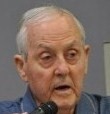 |
This is a picture of myself when I first got to Japan. My prisoner number was gohyaku-ju-yon, 514. We were issued a coat. It was very cold in Niigata because we had snow most of the year actually. You can pass that around if you like. On the back you have a diagram of the Bataan Death March.
The Death March started at Mariveles. We were told that we would surrender to the Japanese. I came up to this man, this Japanese officer, and he pointed to my wristwatch. I gave it to him. He pointed to my ring. I gave it to him. He pointed to my blanket. I give it to him. Whatever he wanted, I gave it to him. He pointed at mess kit. I gave it to him. And then we started walking down the highway. We walked 65 miles. We were never given any water. We were not given anything at all, nothing whatsoever. If you fell out or if you could not continue any longer you were either shot or bayonetted.
They were walking us to a railroad town called San Fernando. We had no idea what was happening because we were never told anything. We were just told to march on. I was only nineteen years old and some of the older men could not continue and so they died.
We got to San Fernando. This is when they first time fed us. I still remember they were cooking rice in steel caldrons with wooden paddles. And they started feeding us there, but unfortunately about fifty feet away were the latrines so this was a problem where the dysentery started. The flies would go from the latrines to the food and so forth.
So then we were put on a train and sent north to a Camp O`Donnell. Well, we got to Camp O`Donnell about sixty miles north and we walked into the camp. I had never seen anything like this. There were bodies lying along the barracks. People that were - just dead. And the stench, the odor was terrible. And I said to myself, "John, if you stay here you gonna die."
So I volunteered for Japanese orders...work details and they put me on a truck and I went right back to Bataan. This time I rode in a truck. I did not walk and I worked there fixing roads. Now Corregidor, this is an island in the Manila Bay, they were still fighting. They would not surrender for another month.
They had so many deaths at Camp O`Donnell that they closed it up and had a new camp called Cabanatuan, which was north of Camp O`Donnell so I got malaria the second time when I was on Bataan. So bad and everyone had to go through the shakes. And the only medicine that the Japanese had liquid quinine that saved my life actually.
At Cabanatuan there had what they called a hospital side and a duty side. In the hospital side you didn`t work and that is where I had the malaria. I could not even walk. I was in such bad shape. We grew vegetables at Cabanatuan. We had a farm. We grew vegetables for the prisoners and for the Japanese soldiers, too.
The rumor was that if we were issued new clothing, new shoes, new shirts, and so forth you were going to Japan. Japan needed workers because most of the men were in the service. So they needed workers so I went to Japan in 1943. I was very fortunate.
That is a picture of when I first got there. They took a picture of a dedication photo and so forth. My first job when I got to Japan was planting the rice in the rice paddies. We took our clothes off and just wore shorts and pretty soon I looked down and I had all these black things on my legs. Well I had never seen a leech before. And so this Japanese soldier took his cigarette and he burned them off my legs. That was my first job in Japan.
That is all about I want to say.
Mr. Douglas Northam |
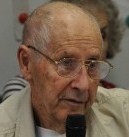 |
Good afternoon. I am Douglas Northam and I was a Navy personnel stationed in China just before the war started. And we made it from Shanghai, China down to Manila Bay the day before the Pearl Harbor bombing.
And so we did patrol duty between Corregidor and Manila and Bataan after Bataan had fallen. A month after Bataan fell then Corregidor was surrendered and we were taken to prison camp Cabanatuan in the Philippines and we were forced to live in filthy conditions with no way of cleaning ourselves, with no medicine for our illnesses, and a starvation diet.
I was transferred to Japan in November of 1942 on one of so-called hell ships that again, we were forced to live in even worse filthy conditions on that trip which lasted about three weeks. When we got to Japan we were divided up into different groups for our places where we would be working and I went to Umeda bancho, which is in Osaka. We thought that conditions would be better there, but it turned out that they were the same.
And the diseases that we all developed while we were in camp we are still suffering from some of them even today. And it is a miracle well I suppose that any of us are still alive.
The Japanese people and the American people have a lot in common. We are family-oriented. We have a high work ethic and we like the game of baseball. And it makes us wonder what all that fuss was about seventy years ago. And since we are all towards the end, we would like an apology from the companies and their organizations that kept us in custody when we were POWs. And then we could extend our hand in forgiveness.
Mr. George Summers |
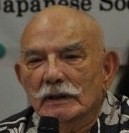 |
Well, I wish that I could talk for more than three minutes, but I just want to emphasize the fact that we are here to promote friendship. And all I want to say to you in Japan that I am your tomodachi okii ne. So, anyway, I am talking as prisoner of war we had the atrocity of the war, which was the Bataan Death March. The appalling burning of the prisoners and so many others. And, also the fact that how prisoners of war felt about your Emperor. We were treated with General Wainwright and what we should do with the Emperor.
I understand that about General Wainwright and the Emperor. We want to promote an exchange or seek revenge upon your Emperor, but because of your culture and I understand your culture because at that time you were winning the war and I feel just the same as Japan does to pick dirt to go through the spoils. And that is way it should be. Your culture is that way and American culture is a little bit different because America promotes friendship and negotiation, so however I want to bring that to your point that is in the past and today, is the new Japan. And I trying to express that I have great friendship for you. The only problem that I had as far as a prisoner was concerned was with at the end of the war our great Douglas Wainwright who I know most Japanese love for all that stuff what he did that our POWs would never get any reparation. So American prisoners attempted to get reparations, but never did throughout the years so we have been asking for an apology. I mean Douglas MacArthur.
So to continue on it was very hard for the prisoners. We still feel that we have not really been treated right, but it has been over seventy years and the new Japan is here now and been laid in the dust. Slowly brought up once upon a time. Once and again, never so often. It has been going strong these pass thirty years.
I will end that now and I will now tell you about my experiences. And my experience was that I was located in Guam, a beautiful island, paradise. So on that day, Dec 8, I was on guard duty in a town called Sumay in Guam. And all of sudden ... planes. About four in the morning here they came by. The sunrise was coming up and they bombed Sumay and ... natives took the duty here. I was struck right there on the dock ... rushing up, some worked machine guns.... Scooping up coconut groves and get lost there. I was waiting for our Colonel or whoever it was to gather us in, but he never showed up. So anyway they bombed our barracks, which was close to where I was supposed to be on guard duty and I got some shrapnel in my leg. So me and another fellow called .... I think that was his name. We ran up into the jungle. We tried to gather some food. Later that night we went into Sumay, which is a dead town because all you could hear were the dogs barking. We had to find some food and stuff like that. So we just hide away.
Right around December 11, my leg swelled up because of the shrapnel that was in my leg and I came into my barracks where the Japanese forces were and a machine gun opened on me. It hit my feet and I ran back into the jungle. A native came up with a truck full of coconuts and he said, "You are going to be dead, because the Japanese have issued an ultimatum that anybody who has not surrendered will be killed on the spot". So when I heard that shot there I did not know what the heck to do so I waved my shirt as a truce and they did not shoot anymore and I came in and they brought me to the Colonel who interrogated me and called me a hero. And he gave me corn beef and tablets because I was starving to death. And then he sent me back to the Catholic Church for the rest of our prisoner days. We stayed there until after Christmas and New Year`s and then we embarked on the Argentina Maru.
I think there was about 450 and odd of us in the Navy and Marine Corps. We were thrown into a hole. Thank God we were only there for three days, but in the meantime we were all starving to death, freezing to death, we had nothing but patches and short pants. And there was one rice ball among two of us. We had all kinds of urination and ... It was horrible.
Finally we reached the island of Shikoku and I remember getting off the ship, which was around February or late January. We were freezing to death and we were marching through beautiful little towns. I saw some beautiful lights...Everybody happy. There was dancing on the streets. I could see all the fruits and vendors. I said to myself, "What a beautiful town if only they would let me come down and get some food." So anyway they marched us to a place called Zentsuji.
It was quite a long story and I have taken up too much of your time. So, I will pass it on to the next person.
Mr. David Farquhar |
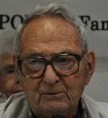 |
Well, I am different from everyone else that is up here. They were all prisoners for three and a half or four years. I was a prisoner for just three and a half months.
The thing I was trained for in the United States was to be a gunner in a B29. We moved to the United States after training on Tinian, the north island, which was the largest air force base in the world.
During our missions from North Field on Tinian we flew what were called seven general purpose missions where we dropped 500 pound bombs on factories and anything like that we could destroy. A normal mission was fourteen hours. Our longest mission was a radar mission and we flew radar over the Inland Sea, all the way over to Korea, and all the way back to Tinian. We were looking for ships and every night, night after night, a different crew would fly to Japan looking for ships and we had a special radar person who could very carefully pinpoint those ships on a map.
Months after that we flew four mining missions and dropped 2000-pound mines in the water where the ships were located and we knew exactly where they would be, so these mines were laid. The mines had special mechanisms in them. Some of them only went off with high or low frequency sounds, which were big ships. Some went off with any magnetic sound that went over them. Some of had devices in them that could count random numbers so they might go off with ship number 13 or ship number 19 or some other number like that. So the minesweepers could sweep and sweep and sweep, and then when a foreship would go over, it would get exploded. We sunk more ships with these mines than all the submarines in the Pacific.
Our first mission was February 18, 1945 and our last mission was February [correct: May] 23, 1945. It was a very short period of time. We were flying over Tokyo on our last mission in a plane trying to burn down the city and we were caught in the search lights. We were shot down. Our plane was set on fire. The left wing was burning. We flew across Tokyo Bay and we bailed out in a small town just east of Tokyo on the other side of the bay. And we landed out in the countryside near rice fields or trees or other things. After flying across over the bay, we all bailed out. There were eleven of us on the crew. We bailed out.
It took eight days to capture one of them, but I was captured at the end of the second day. I was taken to a little local jail and then we were turned over to the military police or the army. And the army turned us over to the Kempeitai, which was a military like the Gestapo, that imprisoned us and they did not call us X prisoner or prisoner-of-war. They called us special prisoners and we all supposed to be killed eventually.
The Kempeitai was located right next to the Imperial Palace and there was a big building, a main building, and there was a wooden building outside called the horse stalls and we were put in the horse stalls, which were made into six cells, and we were put in there about two or three days after we were captured.
I collected articles about the special prisoners and about half of all of the special prisoners were captured or found dead, so anyway half of them were dead and only half came home.
On or about August 15, we were all supposed to be killed, but instead the Colonel decided to send us to Omori from the horse stalls. And we were sent to Omori. At Omori we got a bunch more food and about fifteen days later on August 28, Omori was the first camp in all of Japan to be released. We were released, picked up and taken to a US hospital ship that was in the Tokyo Bay, the USS Benevolence.
Well, very quickly from that time on we got rid of all of our clothes, which were filled with fleas and lice, and gave us a Navy uniform that was like an army uniform and we stayed in the hospital for about a week. We were transferred home and went from hospital, to hospital, to hospital until we finally recovered.
Mr. Randall Edwards |
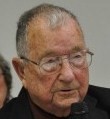 |
I`m Randall Edwards. ...Hyaku-yon hoken renchu...
I started out in the Navy on the USS Canopus in the Philippines. We were the mother ship for the twenty-nine submarines we had in the Pacific. The Canopus was bombed numerous times, but she continued servicing submarines until April 9th, 1942. When General Wainwright surrendered Bataan, I had left the ship in December and had joined the Army on Bataan. The last orders I got from the Army on Bataan when they were surrendering was, "Randall, you are on your own." I had my choice I could go with the Philipino and maybe try to get through the Japanese line or go back and join the Navy down in Mariveles. The only trouble is that when I got to Mariveles was ...... I got down to Mariveles, the Canopus was out in the middle of the bay sinking. She had been sculled. Me and two other guys swam over to Corregidor. I was on beach defense on Corregidor with the 4th Marine Battalion, Navy Battalion.
The island of Corregidor was surrendered by General Wainwright on May 6. We were became prisoners. We were not prisoners of war. We were just prisoners. Japan had not signed the Geneva Treaty.
We were transferred to Cabanatuan where most of the rest of the prisoners were and after only three weeks in Cabanatuan we were pulled out and loaded on a ship in Manila. It was the Tottori Maru. I do not consider her to be one of the hell ships. We had 1500 men, Americans, on there and about 1500 Japanese soldiers on the same ship. We had room on deck for half of us at a time. The captain of that ship permitted us to bury our dead sliding them out from underneath an American flag into the ocean.
We left Manila and we headed for Formosa, which is now Taiwan. We were in and out of Taiwan about five times because of submarine attacks. The Japanese finally unloaded the Japanese troops in Taiwan and took the ship and the American prisoners closer to the China coast to shallow water and took us to Pusan, Korea.
This is November and Pusan, Korea at this time is pretty cold. Most of us still only what little uniforms we still had were summer uniforms. Some people got Japanese clothes. It was the Japanese summer type of uniform – a canvas like sort of affair. We were put on a train and headed for Mukden, Manchuria. We arrived there on November 11, 1942. It was raining. It was cold and most of us did not have any clothes.
Our first camp in Mukden was almost like an American hog farm. It was an old Chinese army camp. We were five kilometers from the factory where we were supposed to be working. We built the factory from the ground up. We installed machine tools in that factory.
We did everything in the next three and a half years to prevent the Japanese from winning the war. We sabotaged the machines. We stole their sake. It was rough, though. The first winter we lived on cabbage soup – Chinese cabbage soup. We lost 250 men out of the 1200 that went up there at first. So, you can see things were not very good.
We were supposed to be an elite crew to build the factory for MKK. We were contracted as slave labors. And that was it. We had no rights. We had no privileges. We had nothing. We were not considered to be prisoners of war. We were not the only ones that were being mistreated. The Koreans were being treated just as badly as we were.
We had two interpreters up there in the camp. One by the name of Minoda, and other by the name of Kawashima. They were probably the meanest two humans on the face of the earth. And they were American citizens. One was from Honolulu, and the other was from Los Angeles. They made it very clear that Japan could not win the war. They were going to be executed at the end of the war, and they did not give a damn what they did to the prisoners of war.
At the very end of the war, we were informed that if the United States invaded Honshu that the prisoners of war would be executed.
There was an OSS troupe who parachuted in close to our camp and they were themselves prisoners until the Japanese learned that the war in Manchuria was really over. We were there for another month after that. I was weighing myself in a ... brewery. I weighed forty-four kilograms and I was one of the healthier ones.
General King and General Wainwright surrendered 23,000 Americans in the Philippines. 10,000 came back. I can`t say anymore.
After the war, we were transported on a Navy ship out of Port Arthur (Lushun). We came to Okinawa. We were in a typhoon. We lost the bottom of our ship when we hit a mine. Um, good things like that. After that I stayed in the Navy. I retired from the Navy. I went the University of Florida and got a degree, and then worked in fusion research at Oakridge National Laboratory. Japan is a part of that program.
Mr. John Leroy Mims |
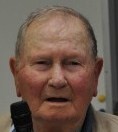 |
Thank you. I appreciate all of you being here. I want to say that my kindest regards to all of you. I love all of you and there is nothing you do can do about it. Now, I want to make sure each of you get one of these cards before you leave, if you don`t mind. Don`t trash it, but put it in your museum. That is where it needs to be. I started out in an Indian reservation.
I don`t have my hearing aids and I don`t know what this beautiful lady is talking about. I know that she is saying something nice. But anyway, do you want me to go ahead?
OK, I came into this world on an Indian reservation in northwest Florida. I think that is the reason why I survived during the war. I had followed my uncle in the forest and ... leaves or trees or crackle...and when I walked, we were supposed to walk softly and quietly. He had a mean stick. That is what the Indians ... , but the only thing about me. I was white-headed and blue-eyed on a reservation.
OK. Going back to, I joined the Service the second time on February 15, 1941. I wound up with this unit here. If you can see this medal here. 31st Infantry Regiment in the Philippines.
And I thought I was the best looking soldier in the Army. We still have reunions and I still think I am the best soldier that was in my outfit. There is only one of me left. We took a picture of our unit on the streets on August 15, 1941 and I am the only cotton-top on the top of that picture that is still alive.
Then we go on to the Philippines. I was assigned to this unit that I am talking about – the 31st Infantry Regiment and we took our basic training at Fort William McKinley in the Philippines. Anyway, it was the hottest place on earth, we thought, all of us that was taking our basic training.
Anyway our instructors kept telling us don`t drink the water. Just don`t drink the water. It will kill you. Well, we wondered what we could do. All of us were seventeen, fourteen, twelve – in that age group to seventeen or eighteen. And one of the sergeants got us together one day when the officer was not around and said, "What you got to do is get Genebra and a bottle of sarsaparilla and put it in your canteens. Don`t drink it. Sip it. It will save your live." And even though when I go through some of these Death March reunions now in New Mexico, or Virginia or wherever I go, I know that when I go on a march, don`t drink but a sip of water.
One of the officers (name) he was our training officer. He caught a bunch of us when we were trying to drill and he saw all of us weaving and waving with the wind. He said, "What is wrong with you troops?" He did not know that the sergeant told us to drink the Ginebra, the gin and sarsaparilla. There was nothing with us, there must be something wrong with him.
OK, on the Death March. All of that they talk about through here is going to work off on me. Now the only thing we were told to do is surrender, but they told us. I was in an Infantry unit and we were supposed to stack our rifles like we do in the company in Manila. Well, we did not stack our rifles. The bunch that I was with we put them in creeks and waterways. The way the war was running that is the way we put our rifles. Our reason was that if we got ammunition or could use them again or escape, we could get our rifles back and use them. We started off with 03 rifles and wound up with M1s, but I had thought ... fire that the army had.
Anyway, after that I started what they call the Bataan Death March and I did not know at the time I later found out we had disgraced two (Japanese) Generals. The reason why we disgraced those two Generals was because they did not bring enough troops into the Philippines to take the islands. Every time they would fence us in, we would eliminate them and they would have to wait until they got more troops in. It was not all our fault the reason why those two Generals did not get what they wanted.
Anyway that is when I found out there was the Bataan Death March. I found out from a guy from the Tokyo Police Department. The chief had a Harley-Davidson motorcycle that he got out of China where he run the Navy, Marines, and embassies out of China and they come in to help us. Not the Japanese, but he had a motorcycle and that is where he got it. He dropped a bottle of Coca-Cola in front of me as we were marching by and the gentleman that I was I picked it up and handed it back to him. Well he eliminated all my teeth right there on the spot. He hit me with that bottle of Coca-Cola and hit my teeth and they just shattered. And I spit all my teeth out when I got a chance after he let me go.
He told me the reason he did that because all of the Japanese soldiers around would think that he is scared or he did not want to kill all of us. He was educated in California and he did not mind telling me that either, but he had no recourse except to do that. Now I believe him. After that he was one of the best Japanese soldiers that I knew. I think Watanabe was his name.
OK, now the next thing to talk about is our marching back and forth. Some of these people had less than 100 miles to march. We had part of the time, we had over 100 miles. What happened the Japanese had ordered the Death March and ... beat off some and killed some, turn us around and send us the other way. I do not want to hurt any of your people feelings because I love all of you, but I just thought I would let you know how it was back in the 1800s (1900s).
The next thing when I got to Camp O`Donnell they died like flies. The prisoners died like flies. Sometime I can`t remember the names of all the things that they got contacted with something like the black plague something you would be talking to somebody and then they would drop dead right in front of you.
The place we had there to sleep was in rice paddies where there was nothing but leeches would eat your clothes if you had any. And we did not have anything but G-strings and when it got cold, I remembered my Indian heritage, always try to keep your stomach warm.
After that I was sent to Cabanatuan. Cabanatuan was died off. So many died there men. Four rulers in the roads going to the cemetery stretchers taking the dead to the cemetery, which was dug with bulldozers and it rained a lot in the Philippines so sometimes you would dump a body in there and they would try to get out of there by the shock of water, they would come back to. The Japanese did not want them to come back to. They would bayonet them or push their head back under the water.
I got sick there. I mean to where I could not go and they kept transferring me over. They had four buildings. One was building 0 to 4. And uh, I would crawl back at night when no one could see me. That is where I met a Naval doctor by the name of Nardini. I have never seen him since to thank him for saving my life, but I could not even get up on my hands or feet or anything. He would come in and I do not know how many times he would see me. If they are zero ward and I tried to get back to my ...., you know. I am going to make the rest of this real fast because I run two minutes over. From there, the doctor went and got me some burnt rice and he said, "you nibble on this until I come back." Anyway, it was almost like burnt leather, but I nibbled on that and when he came back he got me and put me on duty to Clarke Field.
Anyway, after I got to Clarke Field I was driving trucks for the Japanese, cutting grass on airfields and what not, and I escaped. And they wanted to punish me for it. They took a bulldozer blade and put on both of my legs and broke them. I thought that was pretty stupid. I could not work after they broke my legs. They said that they were doing me a favor and sent me to building a prison in Manila. And that it where I was when they took me out of there, and put me on a ship to go to Japan. Anyway, on the ship to Japan it took 62 days and 62 nights to go less than 600 miles. We lost just about all the people that were on the ship except as long as I remember about 500.
I was undecided now about the coal mine, but I know that it was in Japan. They ship me in the coal mine and forgot me except one that released me out of there. It took us two months to get us a bullet train out of there. I believe it was Shimonosaki where a hospital ship was waiting on us.
Anybody want [me] to say anything more. Check with me later.
Mr. Robert Ehrhart |
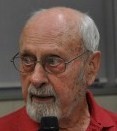 |
I was seventeen when I enlisted in the Marine Corps about a year before Pearl Harbor. After about six months of training in the States I was transferred to the Philippines. We were on our way to relieve the Marines in China, but the war clouds were getting very bad and so were we sent over to the Philippines. In the Philippines very fortunately we got there about six months before the war we got more training, which probably one of the reasons why I am still here today.
When the war started I was in Mariveles and we were immediately, we spent a short time in Bataan, very short. The Marines were ordered to go to Corregidor. We were assigned to the beach defense. We got to Corregidor just at the time the first time it was bombed and we were told at the time that the barracks there were bomb proof. I was very tired so I climbed up to the 2nd story and laid down on the concrete and went to sleep. The next day the first bombing of Corregidor occurred and where I was laying one of the bombs came through the roof through the 2nd and the 1st floor and went down into the basement and exploded. This was in a room right next to where I was laying. I got really got religion that time.
I was not in Corregidor for more than a couple of days and we were transferred to a little island near Bali called Fort Hughes. This is where I spent most of the action and from that position we could see Corregidor very well. When the battalion fell all the guns from Bataan were lined up on the beach on one side. And on the other side of Manila Bay they were lined up, so we were being getting shell fire from both sides and I could look over to Corregidor and I saw it disappear in the dust and smoke and fire. We looked and we said that there cannot be anyone alive, there cannot possibly be. Again, we were lucky enough I guess. The casualties were pretty bad, but not as bad as had expected. We held out for about a month after Bataan had fallen.
And General Wainwright surrendered the islands. And we were surrendered and then transferred to Corregidor where we buried the dead. We did a lot of work there. It was sort of hell on wheels because we were not fed, and we had to get food from the dead. But we had to eat it at that place because we could not bring it back to camp because they were searching us and would bayonet us if we were caught with any food. We were not in the .... for more than a few weeks fortunately.
We were then transferred to Cabanatuan. Our march was not nearly as bad at the Death March; however we were packed into box cars so that if a man died, he could not fall down. In Cabanatuan I was on ...duty for a short period of time. Then we were transferred to a farm, so we worked on a farm. The produce from the farm was almost all for the Japanese guards. We got the tops, the potato tops, and things like that that did not agree with us very well, but we had to eat it.
I forget how long, about six months or so, when the prisoners from O`Donnell came were transferred to Cabanatuan. At that time the death rate went up from a few a week to forty a day. And the Marines were then transferred to burial detail. The burial detail was agony. It was dirty. The bodies were laying in the hot sun and many of them were decomposing greatly. Picked them up and put them on litters and carried them several miles to the grave yard.
I was then one of the early ones fortunately to be transferred to Japan as slave labor. Those of us who were assigned to one of the early hell ships, which was very fortunate because the submarines were still using WWI torpedoes and many of them were duds. We turned out at Taiwan and we took a torpedo. She bounced off our hull. I do not know where the other torpedo went, but fortunately it did not hit us.
The ship was the Taga Maru and I think we had about 800 on board. We buried seventy at sea. The conditions were horrible below deck. The hatches were locked above us, so the only air we got was from the ladder from above. We were packed in like sardines. Feet, feet, head, head. We landed in Japan and the most luxury thing we had a train ride to Sakurajima, where I worked at a riveter. We built oil tankers, which the Japanese needed and also against the Geneva Convention we made corvettes- the military warships.
In Osaka to keep my sanity I drew cartoons. My cartoons were sort of a leger or a diary. It kept my barrack mates morale high in my barracks. I guess about nine months. I hid them in a stack of toilet paper. There are about 12 inches square and I cut out the center and hid them in that and I kept it in my barracks bag and went to work. I came to work one day and came back for lunch and all of our barracks bags were all over the floor. Mine was all over the floor. The toilet roll had disappeared. And for two weeks I sweated every night when we came back from the ironworks because I knew that had my cartoons and if they had ever seen what was on the back of them in between the little words in there I would surely be executed, but evidently they did not. Evidently they were so angry to see the cartoons that they did not and it was pretty hard to read. When I got home I could read it, but anyhow for two, for a couple of weeks, I would standing waiting, they would call you. If you got into any trouble you would get called. When you came home at attention. At night before you go to eat, I would wait for my number to be called. That was almost as much torture as what happened when they did call my name. Finally they called my name and well, they had to carry me into the hospital.
Which was not much of a hospital. All they had was a little bit of quinine and charcoal that they fed us for ... After I recovered enough so that I could stand up, they marched me out behind the barracks. And I had to stand at attention all night long with the sleet coming down. With the snow my back was frozen. My hands froze and I must have collapsed because the next thing I knew I woke up in the barracks and the fellows had saved their charcoal. The barracks was open at both ends so the wind would blow through. The fire buckets would get about 3 inches of ice at night. Anyhow they saved their charcoal and revived me.
Anyhow we put up with them wandering into camp and looking for trouble. You would get beaten if you had a button loose or anything. Any small thing. After the Air Force bombed Osaka, they burned the entire city down. We were on a little island, Sakurajima, and we were spared, but they could not feed or care for us anymore so we were transferred to Akinobe.
Now Akinobe was a copper mine. A ... was large drill which weighed about 75lbs. I weighed 98lbs. My drill was 75 and it was hydraulic. The drill was forced into the mine and you drill in there about six feet and pack it with dynamite and then blew that section out. Well, we worked there until about August 15th when the hostilities ceased.
And we knew that the war was going to be over because the B29s were no longer flying over. There were no more air raids. And finally our guards disappeared from the camp. Anyhow then the war ended and we commandeered a train and wound up in Yokohama. And from there we came home.
Closing address (Representative of POW Research Network Japan) |
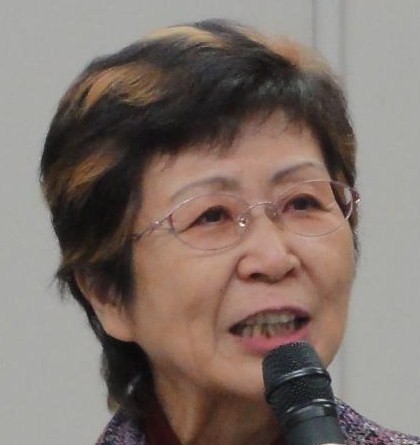 |
Thank you for coming and talk to us today. Flying across over the Pacific Ocean to visit Japan is a serious matter physically at your age. But for you, I believe, to overcome emotional turmoil was much more serious matter. For visiting Japan again, you must have had to overcome warring emotions. Each of you must have had various feelings and emotional turmoil about Japan and the Japanese people. Nevertheless, you testified your bitter experiences of wartime in front of us. All of us would like to express our gratitude anew for your having talked to us in such circumstances. Everyone, please clap your hands again for those who have testified. Thank you very much.
Now, those of us who have listened to the testimonies, there are things we have to do in Japan. As mentioned in the handouts, we should know that 40% of the US prisoners of war died in their captivity, which means those who have survived had received how much damage physically and mentally. We have to know that. At school, we learned about the Potsdam Declaration, which Japan accepted. In the said Declaration is a clause, which reads, "Stern justice shall be meted out to all war criminals, including those who have visited cruelties upon our prisoners."
In the International Military Tribunal for the Far East, commonly called Tokyo Trial, which was held in accordance with the Potsdam Declaration, a number of evidential documents regarding POW atrocities were presented. Then, not only the US, but also Great Britain, Australia, and Dutch POWs inclusive, it is recognized that 27% of the Allied POWs perished in their captivity. However, those of us who received the post-war education have learned little about those facts. Those of us who have learned such facts, today I see many young people are here in this room, I would like, with the visitors, to continually carry on the activities for researching accurately why Japan committed POW atrocities, and to such serious extent, and hand out the clarified facts to generation after generation.
Finally, during the Philippine Campaign, you fought as the US-Pilipino Forces. Therefore, other than the US POWs, there were great many Pilipino POWs as well. In addition, the British Forces were consisted of the British and Indians, so, there were Indian soldiers. There were Malaysians and Chinese. And then, in Java, there were Dutchmen and Indonesians. Therefore, when we consider the POW issues, I would like, at the same time, to consider the other heroes, the Pilipino POWs who are not here today. I will not forget about the POW issues on the Pilipino POWs who fought with you.
A while ago, someone mentioned, "We, the Japanese and Americans, have a lot in common. And it makes us wonder what all that fuss (war) was all about?" In order not to repeat such a foolish war, we would like to learn a lot of things from your testimonies, and engage in various activities to enhance peace between the Unites States and Japan. Thank you very much for kind your attention. I thank the family members for your attendance.